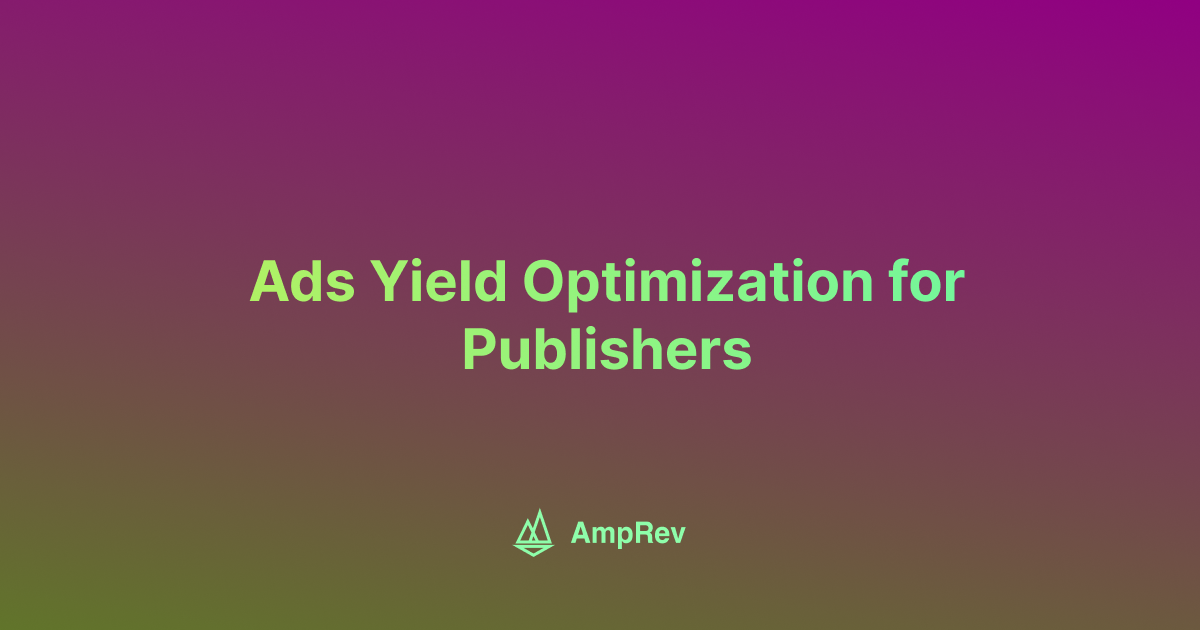Ads Yield Optimization for Publishers
AmpRev

Being a publisher in today’s digital world is a balancing act. You want to maximize your ad revenue, but you also don’t want to annoy your audience with intrusive ads. That’s where ad yield optimization comes in. It’s all about fine-tuning your ad strategy—pricing, placement, and demand sources—to squeeze the most revenue out of each impression. And trust me, getting this right can make a huge difference.
What Exactly is Yield Optimization?
In simple terms, yield optimization is the process of getting the highest possible revenue from your ad inventory. It’s not just about stuffing more ads onto a page—it’s about smart strategies like dynamic pricing, strategic ad placement, and leveraging AI to make real-time bidding decisions. Here are a few factors that influence ad yield:
- Market Demand: Adjusting pricing dynamically based on advertiser demand.
- User Behavior: Placing ads where they’ll generate the most clicks without disrupting the user experience.
- Auction Dynamics: Tweaking real-time bidding (RTB) strategies to ensure advertisers bid higher for your ad space.
Yield Management vs. Yield Optimization: What’s the Difference?
Yield management is a subset of yield optimization, but it focuses more on pricing strategies. The goal? Adjusting ad prices dynamically to maximize revenue. Here’s how you can implement yield management:
- Dynamic Pricing: Change ad prices based on seasonality, user intent, and historical performance.
- Price Floor Management: Set minimum bids to prevent underselling your inventory.
- Inventory Allocation: Prioritize high-value demand sources while maintaining fill rates.
- Demand Segmentation: Customize pricing for different advertisers based on their bidding behavior.
Top Ad Revenue Optimization Techniques
1. Header Bidding
Instead of the old-school waterfall method, header bidding lets multiple advertisers compete for impressions in real time. More competition = higher CPMs and fill rates.
2. AI-Powered Pricing
AI-driven algorithms can analyze real-time demand and set floor prices accordingly, ensuring that you always get the highest possible bid.
3. Ad Placement Optimization
A/B testing and heatmaps help determine the best-performing ad positions. Sometimes, just shifting an ad a few pixels can boost engagement significantly.
4. Private Marketplaces (PMPs) and Programmatic Direct
By negotiating direct deals with premium advertisers, publishers can lock in higher CPMs and avoid the volatility of open ad exchanges.
5. Experimenting with Ad Formats
Different audiences respond better to different ad formats—display, native, video, or even interactive ads. Testing different formats can lead to a more engaged audience and higher ad revenue.
The Best Ad Yield Optimization Tools and Platforms
1. Google Ad Manager
The go-to ad server for managing, optimizing, and analyzing ad inventory. Features include header bidding, unified pricing rules, and dynamic allocation.
2. Prebid.js
An open-source solution that lets publishers integrate multiple demand partners for better competition.
3. AmpRev/BiddingStack
Uses AI to optimize ad pricing and placement in real time for maximum results.
4. Amazon Unified Ad Marketplace (UAM)
Gives publishers access to Amazon’s high-quality demand-side platform (DSP).
5. AI-Based Yield Optimization Software
AI-driven platforms automatically adjust pricing, demand sources, and placements.
6. Real-Time Analytics Dashboards
Track revenue performance, bidding behavior, and audience engagement at a granular level.
The Challenges of Ad Yield Optimization
Despite the benefits, publishers face some hurdles:
- Ad Fraud & Invalid Traffic: Bots and fake traffic can lead to revenue loss and even account suspension.
- Page Load Speed: Heavy ad scripts slow down websites, increasing bounce rates.
- Privacy Regulations: Balancing GDPR and CCPA compliance with revenue optimization is tricky.
- User Experience vs. Revenue: Too many ads can drive users away, so finding the right balance is key.
How Amprev and BiddingStack Supercharges Yield Optimization
If you’re looking for an all-in-one yield optimization solution, BiddingStack is worth considering. Here’s what it offers:
- Unified Header Bidding Stack – Combines Prebid.js, Amazon UAM, and Google Open Bidding to increase competition for inventory.
- Server-Side Prebid – Reduces page latency while keeping revenue high.
- Real-Time Analytics – Tracks key metrics to optimize ad placements and pricing.
- Dynamic Floor Pricing Automation – Uses AI to adjust floor prices based on real-time demand.
- Commission-Free Ad Management – Keeps more revenue in publishers’ pockets.
- Easy Integration – Simple setup with a single tag—no complex coding required.
What’s Next for Ad Yield Optimization?
The digital ad landscape is evolving fast. Here are some key trends to watch:
- AI & Machine Learning: Smarter pricing strategies powered by predictive analytics.
- First-Party Data Utilization: As third-party cookies disappear, publishers must leverage their own audience data for targeting.
- Contextual Targeting: Ads based on page content instead of user tracking are making a comeback.
- Video & CTV Advertising: The rise of connected TV (CTV) and video ads is reshaping monetization strategies.
Final Thoughts
Ad yield optimization isn’t just about cranking up ad revenue—it’s about finding the sweet spot between profitability and user experience. Whether you’re fine-tuning pricing strategies, experimenting with ad formats, or leveraging AI-driven tools, staying ahead of the curve is crucial. By implementing the right strategies and using advanced tools like BiddingStack, publishers can maximize their revenue while keeping their audience engaged and happy.
Want to boost your ad earnings without sacrificing user experience? Now’s the time to refine your yield optimization strategy.
